Note: Measurements taken in the anechoic chamber at Canada's National Research Council can be found through this link.
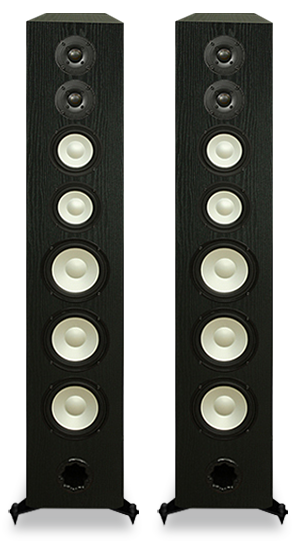
 Though my exposure to Axiom Audio loudspeakers has been limited, it’s been positive overall. The last Axiom I listened to was their new omnidirectional flagship model, the LFR1100 ($4580 USD per pair), driven by Axiom’s behemoth four-channel power amplifier, the ADA-1500-4 ($3230). I came away impressed with that system’s neutral, uncolored, powerful sound, and felt it offered excellent value for a speaker-amp combo around the $8000 mark.
Though my exposure to Axiom Audio loudspeakers has been limited, it’s been positive overall. The last Axiom I listened to was their new omnidirectional flagship model, the LFR1100 ($4580 USD per pair), driven by Axiom’s behemoth four-channel power amplifier, the ADA-1500-4 ($3230). I came away impressed with that system’s neutral, uncolored, powerful sound, and felt it offered excellent value for a speaker-amp combo around the $8000 mark.
But I realized that, with its rear-facing drivers and four-channel power requirement, a pair of LFR1100s requires more space and money than some music lovers are willing or able to commit. I filed that session away under “Glad for the Experience” and saved my pondering about Axiom’s more traditional, lower-cost offerings for another day.
So when Axiom’s M100 v4 floorstanding model crossed my path, it seemed fortuitous. According to Andrew Welker, the company’s R&D Manager, the M100 is a direct descendant of the LFR1100, and its appearance seems to confirm that. Its front-firing design makes the M100 more flexible in terms of system and placement, and its price of $2790/pair makes it more wallet friendly, too. With the sound of the LFR1100 and Axiom’s online information about the M100 fresh in my mind, I promptly said yes to reviewing them, and shortly thereafter received review samples.
Description
I wasn’t quite prepared for what unpacking a pair of M100s entails. Not because they aren’t smartly and sturdily boxed -- in fact, they’re among some of the most sensibly packed speakers I’ve ever handled -- but because they’re quite tall. Each cabinet measures a proud 47.5”H x 9.25”W x 17”D. (They don’t look that imposing when set up, however, no doubt due mostly to their slim front profiles.)
If you have standard 8’ ceilings, as I do, standing an M100 upright and lifting off its carton won’t work. You’ll have to first open the proper end of the box, then lay it down on the floor, grab hold of the speaker, and slide it out, hopefully with a helper holding the box steady as you do the sliding. Easy peasy, so long as you’ve allowed enough space.
A visual examination of the M100 shows that it’s well made for the price. The pair I received came finished in a standard vinyl wrap simulating Black Oak. Nothing special about that, perhaps, but it’s one of the better vinyl finishes I’ve seen, and works well for a speaker at this price. They’re also available in Boston Cherry; other vinyl finishes, real-wood veneers, and piano-black gloss are available for extra cost.
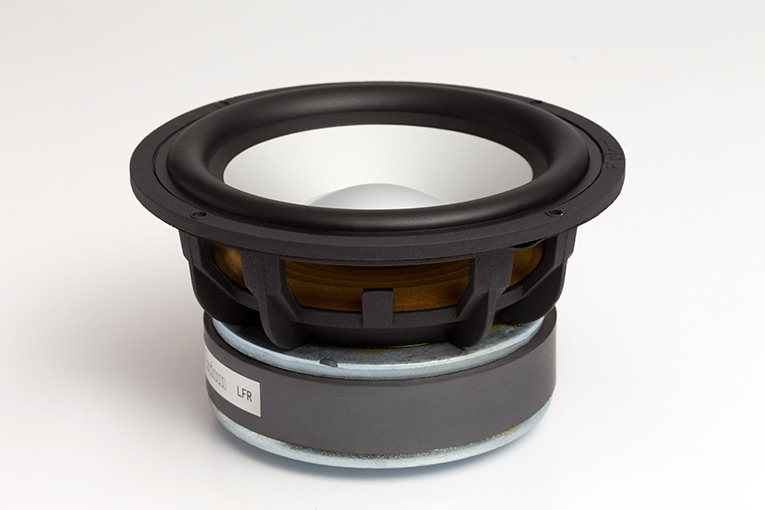
The M100 may look somewhat pedestrian to the casual observer, but a closer examination reveals a carefully balanced, well-thought-out design. For example, Axiom designs and makes all of its drivers in-house, something few speaker companies do, regardless of their models’ retail prices or available resources. Nor is Axiom shy about using those drivers, of which each M100 has seven: two 1” tweeters, two 5.25” midranges, and three 6.5” woofers. Except for the titanium tweeters, the cones are made of aluminum, to keep the drivers’ operational characteristics consistent.
Axiom’s reasoning for seven drivers per speaker is simple: More drivers means increased power handling and higher output compared to speakers having only two or three drivers. It should also help ensure that no single driver operates at anywhere near its maximum limit of excursion during normal operation, which should provide greater linearity and less distortion.
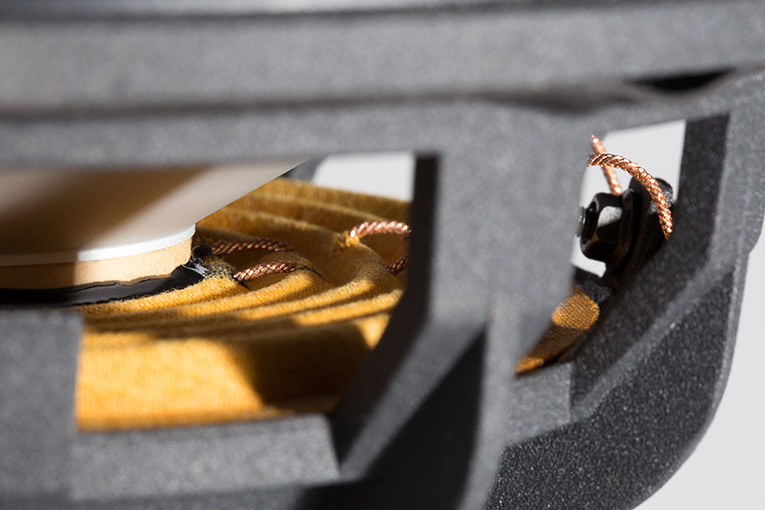
The M100 was designed for those who want full bass response and extension but who don’t want a subwoofer. As such, one of Axiom’s primary goals for the speaker was to achieve linear low-bass extension at full output down to the speaker’s lowest frequency limit: an überlow 31Hz, +/-3dB. Axiom accomplishes this by using larger-than-average voice-coils and roll surrounds so that the woofers can achieve full excursion without compression.
The tweeters feature some design ingenuity of their own. For example, gone is the plastic faceplate Axiom uses in some of their other designs: The M100’s tweeters have die-cast metal faceplates, which effectively turns the housings into large heatsinks. This increases not only cooling but power handling, resulting in less distortion at high volumes.
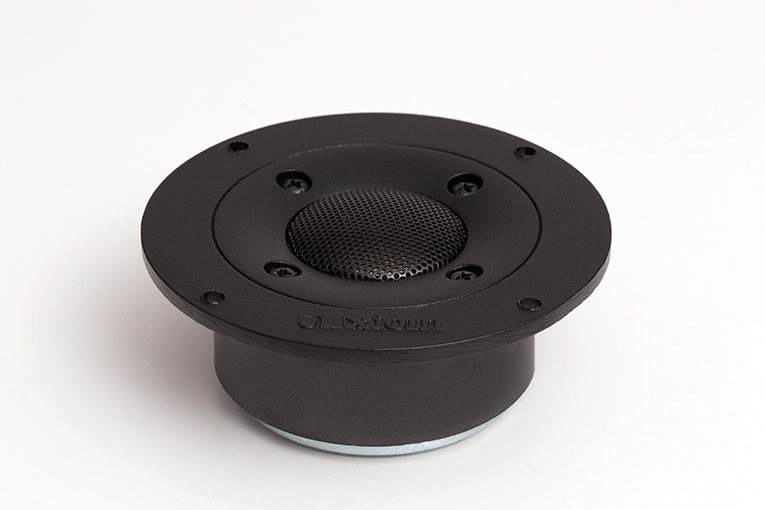
The M100’s configuration of ports seems to be unique. Each cabinet has six reflex ports: one at the bottom front of the cabinet, and five around back. The ports are lined with molded plastic in what Axiom calls its Vortex design, which it says reduces air turbulence and its resulting noise. Welker said that the number and locations of the ports were arrived at through an “intensive investigation into internal cabinet standing waves and port-woofer interaction.” In short, Axiom appears to have paid as much attention to the ports as they have to every other aspect of the M100.
Setup
I put the Axiom M100 v4s in a spare room so that they could break in for 100 hours or so. That done, I set them up in my 20’ x 20’ x 8’ listening room. With bass traps in all four corners, acoustic absorption panels at the sidewalls’ primary and secondary reflection points, and diffusers elsewhere, this room sounds quite balanced and neutral at a variety of locations.
Still, fine-tuning speaker positions always pays dividends. The M100s ended up some 2’ from the sidewalls and 3’ 9” from the front wall, measured from their front baffles, and toed-in by about 15°. This left the speakers about 7’ apart, measured from their centers. At various times I sat 8.5’, 12.5’, and 15’ away from the Axioms.
Listening
Satisfied with the M100 v4s’ positions, I spun up Grizzly Bear’s awesome disc of modern rock, Veckatimest (CD, Warp 0182). The album’s mix of deep bass, wide dynamic range, and varied usage of acoustic and electronic instruments sounds best through speakers capable of handling such demanding extremes, and it took only the first track, “Southern Point,” for me to hear that the Axiom M100s were handily up to the task. The sound they poured into the room was loud, deep, and clean, with a generally even-handed tonal balance and an effortlessly dynamic sound.
In fact, the M100 was among the most dynamically expressive speakers I’ve heard this side of $3000/pair. Regardless of how hard I drove the review pair, they always sounded clean and composed from soft to loud, with no audible distortion or compression. This was most apparent in the bass, such as that on “All We Ask,” also from Veckatimest. The M100s delivered thunderously deep, rich, taut bass that I could feel resonating throughout the room as much as I could hear it.
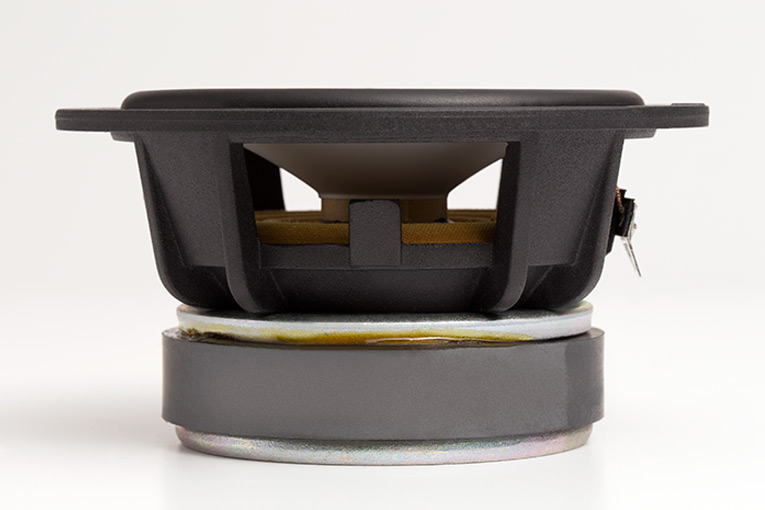
Just to make sure I hadn’t set up some serendipitous pairing of recording and speaker, I played Harry Connick Jr.’s classic trio album, Lofty’s Roach Soufflé (CD, Columbia CK-46223). The title track’s kick drums hit with impact and authority, portraying a realistic sense of weight and scale similar to what one would hear live. Unlike most speakers at this price, the M100s never failed to lay down a convincingly solid foundation.
But the M100 could do more than just dynamics and bass. Stile Antico’s Music for Compline (SACD/CD, Harmonia Mundi HMU 807419) highlighted the Axiom’s tonally neutral midrange, even if it was mildly recessed overall. Voices sounded natural and well defined, without any etch, smear, or artificial edge. It was easy to follow distinct harmonic threads within the musical whole in Thomas Tallis’s “Miserere nostri,” for example, and individual choral sections were nicely balanced with each other.
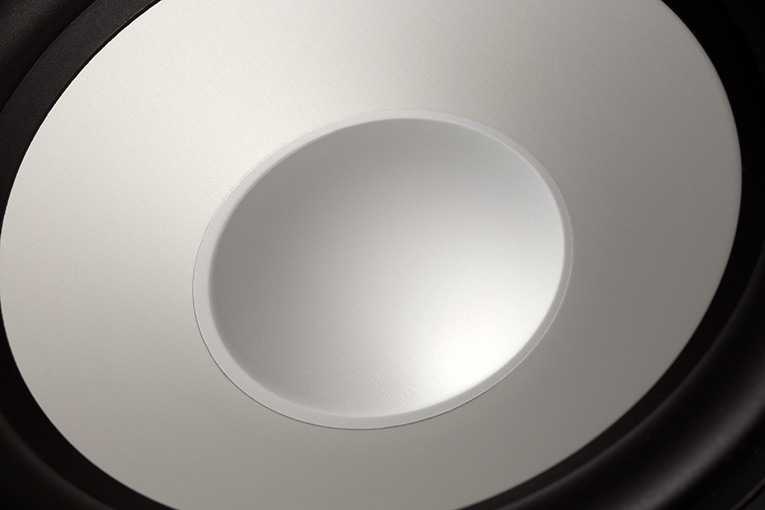
Lower-treble sounds, such as the cymbals in Lofty’s Roach Soufflé, sizzled with crispness and clarity, the Axioms pushing them slightly forward in the mix. Synth hits and percussion in densely layered recordings, such as Justin Timberlake’s wickedly good but sonically subpar The 20/20 Experience (CD, RCA 88765 47850 1), sounded brilliant and detailed. Listen to how well the percussive chimes stand out from the mix of “Strawberry Bubblegum,” or how the horn section in “That Girl” bites with a realistic sharpness. Though its lower treble could occasionally bite with too much enthusiasm, the M100 made high-energy music come alive.
When I played Esa-Pekka Salonen and the Los Angeles Philharmonic’s DSD recording of Mussorgsky’s Night on Bald Mountain (SACD/CD, Deutsche Grammophon 000718236), I could hear that the Axioms were also capable of outstanding imaging. They accurately conveyed the rich, warm acoustic and huge sense of space of the Walt Disney Concert Hall, filling my room with a large, densely populated soundstage. Through the M100s, I could close my eyes and visualize the musicians playing in front of me: the speakers produced a front-of-hall perspective, with fine precision of depth and imaging.
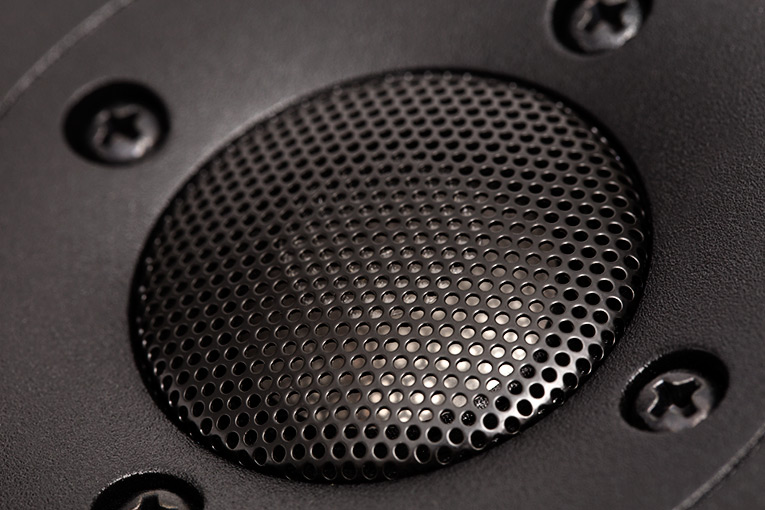
What’s more, the Axiom M100s maintained a remarkably stable listening window in both the vertical and horizontal planes. Within 8-10”, they seemed largely immune to changes in the height of my ears -- I was able to enjoy their imaging qualities with very little change in tonal character. According to Welker, this is a result of using multiple tweeters and midrange drivers in such a way that “the cancellations between the drivers are now staggered, resulting in a smoother overall vertical response family.” Whatever the reason, the result was a pair of speakers that didn’t require me to listen as if my head were locked in a vise.
Comparison
Feeling that I now had a handle on the M100’s general character, I compared it with one of my long-term reference speakers, Aperion Audio’s Verus Grand Tower. Like the Axiom, the Verus Grand is sold direct from the manufacturer with free shipping, has in-house-designed drivers, and a similar three-way configuration of more drivers than the norm -- in the Aperion’s case, five. And at $1998/pair, the Verus Grand is priced near enough to the M100 for the comparison to be meaningful.
Full disclosure: I used to work for Aperion Audio; my last day there was almost two years ago, as of this writing. I still enjoy my Verus Grands -- I think they’re fine speakers that sound great with all types of music. What’s more, their eminently musical, even-handed character works well for long listening sessions. But since my job is to accurately and honestly describe what I hear, that admiration doesn’t diminish my ability to be as impartial as I can be in reporting all of the differences that I heard between the Aperions and the Axioms.
Hélène Grimaud’s brilliant Credo, a collection of music by Beethoven, Corigliano, and Pärt, with Esa-Pekka Salonen and the Swedish Radio Symphony Orchestra and Chorus (SACD/CD, Deutsche Grammophon 4748692), well highlighted a few of those differences. Midbass notes sounded bigger, more cleanly rendered, and better defined through the Axioms, while the Aperions seemed to dig just a bit deeper. A quick comparison with pure 31.5 and 25Hz test tones confirmed that the M100s had more output at 31.5Hz, while only the Verus Grands produced usable bass at 25Hz.
Listening to “Wagon Wheels,” from Joshua Redman’s Back East (CD, Nonesuch 104252-2), revealed that the Axioms had better pitch definition, clarity, and articulation in the lower registers than the Aperions. That, coupled to their greater quantity of midbass, made for a perceptually cleaner yet bigger bass sound through the M100s.
Moving up the audioband, Grimaud’s piano sounded richer, smoother, less “glassy,” and just a bit more realistic through the Aperions. The Verus Grands also delivered more instrumental body and fullness, portraying more of her instrument’s warmth, weight, and heft. Grimaud’s left-hand notes, for example, resonated more forcefully through the Aperions, while the Axioms made those same notes sound thinner, slightly recessed, and a little sharper overall. Right-hand notes, however, had more brightness and presence through the Axioms, which some listeners may or may not prefer.
The two models resolved nearly equal amounts of detail, the Aperions edging slightly ahead. Intricately nuanced textures and details, such as the soft impact of felt drum mallets or the swish of brushed cymbals, like those throughout Alexandre Côté’s Portraits d’Ici (CD, Effendi FND 128), sounded more tactile and textured through the Aperions. The Verus Grands also put forth more complete reproductions of a given note’s attack, sustain, and decay, with cleaner, more extended transients and trailing harmonics. But the Axiom M100s countered with more brilliance and brightness on those same cymbals, while underpinning this with a tighter, tauter, more articulate low-frequency foundation.
When the music’s intensity kicked up a notch or two, the Axioms consistently delivered a bolder, livelier, higher-octane presentation of it than did the Aperions -- especially when I cranked the volume dial up to the proverbial “11.” Bass and percussion instruments, especially those on the Timberlake album, sounded punchier and more impactful from about 80Hz on up. What’s more, the Axioms consistently threw a wider soundstage, and produced more high-level dynamic slam overall.
Without a doubt, there’s a clear winner: whoever purchases either pair of speakers. Both made music in an honest and emotionally engaging fashion, delivering a high level of sonic accuracy and musical satisfaction that few, even only ten years ago, would have thought possible at either price. I already own the Aperions, but I could be equally happy owning the Axioms. However, they’re different enough that some listeners may prefer one over the other. That choice will be made on the basis of personal taste.
Conclusion
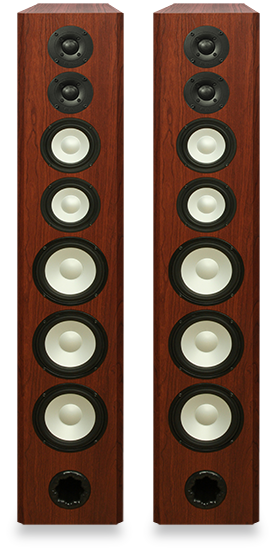 As someone who for years has worked in various capacities throughout the audio industry -- including for a speaker company that directly competes with Axiom Audio -- I’ve heard more than my share of loudspeakers at all levels of quality and price. All of this has taught me that it’s never easy to bring a speaker design to market at a given price and still feel you’ve accomplished all the goals you began with.
As someone who for years has worked in various capacities throughout the audio industry -- including for a speaker company that directly competes with Axiom Audio -- I’ve heard more than my share of loudspeakers at all levels of quality and price. All of this has taught me that it’s never easy to bring a speaker design to market at a given price and still feel you’ve accomplished all the goals you began with.
Perhaps that’s what makes the M100 v4 such a fine addition to the Axiom family. Not only has Axiom met all of its goals for this model; they’ve managed to do so at a price nearly everyone can afford. The M100’s uncanny blend of low-compression, superb bass quality and quantity, and lively yet uncolored tonal balance, makes it one of the most well-rounded, non-hair-shirt, will-please-just-about-anyone speakers you can buy at any price.
Of course, no speaker is perfect, even one as well engineered as the M100; some listeners may ultimately prefer a warmer, cozier sound. I, too, occasionally wondered what the M100s might sound like with just a smidge less lower-treble brilliance and a bit more natural decay and detail.
But those are tiny flaws in what is, ultimately, an accomplished loudspeaker design. I thoroughly enjoyed my time with the Axiom M100 v4s, and I imagine there are quite a few folks who would be pleased as punch with the kind of highly dynamic, excitingly impactful, refreshingly honest sound they delivered in spades in my room. Axiom deserves a gold medal -- or, better still, a Reviewers’ Choice award -- for how much sonic goodness they’ve packed into the wonderful M100. That they’re able to do so for a starting price of only $2790/pair is wondrous indeed. The Axiom M100 stands as one of the best-balanced reasonably priced speakers I’ve heard. Enthusiastically recommended.
. . . Oliver Amnuayphol
olivera@soundstagenetwork.com
Associated Equipment
- Loudspeakers -- Aperion Audio Verus Grand Tower
- Integrated amplifier -- Marantz PM-KI Pearl
- Phono preamplifier -- Graham Slee Revelation M
- Step-up transformer -- Custom-made Sowter Magnetics 9570 (1:10 transformer)
- Sources -- Rega Research RP8 turntable; Lyra Delos cartridge; HP Pavilion G6-2320DX laptop computer running JRiver Media Center; Arcam airDAC; Antelope Zodiac DAC; Denon DCD-CX3 SACD/CD player modified by Reference Audio
- Analog interconnects -- Custom solid-core silver/Teflon (RCA), Blue Jeans Cable LC-1
- Speaker cables -- Canare 4S11 Star-Quad
- Power cords -- WireWorld Aurora 5.2 and Electra 5.2
Axiom Audio M100 v4 Loudspeakers
Price: $2790-$4167.60 USD per pair (depending on options).
Warranty: Ten years parts and labor.
Axiom Audio
Highway 60
Dwight, Ontario P0A 1H0
Canada
Phone: (866) 244-8796 (North America), (705) 635-3090 (worldwide)
Fax: (705) 635-1972
E-mail: advice@axiomaudio.com
Website: www.axiomaudio.com






















